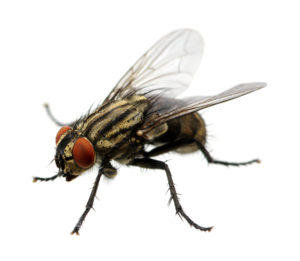 INTRODUCTION: These flies receive the common name of house from being the most common fly found in and around homes, especially in the pre-automobile era and in rural areas. It is not only a nuisance pest but of greater concern is its potential as a carrier of disease organisms, having been found to harbor over 100 different pathogenic organisms It is worldwide in distribution, and is found throughout the United States.
INTRODUCTION: These flies receive the common name of house from being the most common fly found in and around homes, especially in the pre-automobile era and in rural areas. It is not only a nuisance pest but of greater concern is its potential as a carrier of disease organisms, having been found to harbor over 100 different pathogenic organisms It is worldwide in distribution, and is found throughout the United States.
RECOGNITION: Adults about 1/8-1/ ” (4-7.5 mm) long, with female usually larger than male. Color dull gray.
BIOLOGY: The adult female lays her eggs (white, oval, 1/32″/1 mm long) singly but usually in clusters of 20-50 for a total of 75-150 per batch and will lay 5—6 batches in her lifetime totaling 350-900 eggs (maximum 2,387 in 21 batches). Eggs are laid in moist materials, hatch in about 8-20 hours, and the larvae (maggots) go through 3 instars in 3- 7 days at 70-90°F (21-32°C). The full-grown/mature larva seeks a cool, dry place to pupate, migrating up to 150 feet in 3-4 days. The pupa starts out yellowish and changes to black, this stage taking 3 days to 4 weeks depending on temperature and humidity. After emerging from the pupa, about 1 hour is spent drying the wings and hardening the body at 80°F (27°C), with normal activity starting at 15 hours. Depending on conditions, developmental time (egg to adult) may require as few as 6 days. There may be as many as 10-12 generations per summer. Adults usually live 15—25 days.
House flies are general feeders, being attracted to a wide variety of substances from excrement to human foods. Because of their sponging mouthparts, they can feed only on liquids. However, through regurgitation they are able to liquefy many desirable solid foods. Also, a house fly excretes and regurgitates whenever it comes to rest. This habit coupled with its many body hairs and bristles and the sticky pads at the base of the claws on each leg make house flies well adapted for transporting disease organisms.
House flies have been shown to harbor over 100 different kinds of disease causing pathogens, many of which are associated with filth. Such pathogens include those causing typhoid fever, cholera, diarrhea, dysentery, tuberculosis, anthrax, ophthalmia, polio, and salmonellosis, as well as parasitic worms. They have been shown to be disease pathogen transmitters via their vomit, feces, and contaminated external body parts.
HABITS: Although house flies have been shown to migrate up to 20 miles, most stay within 1-2 miles/1.6-3.2 km (55-96% within 1 mile, 77-100% within 2 miles) of their release point or larval habitat if sufficient food is available. Females seek almost any warm, moist material with sufficient food for larval development for egg—laying purposes.
During the day, house flies tend to rest less than 5 feet (1.5 m) from the ground on walls, floors, and various objects. At night they rest primarily above 5 feet (1.5 m) on ceilings, walls, electric wires, dangling light cords, edges/corners of buildings, plants, etc. Their night resting places are usually near their daytime food sources.
CONTROL: House fly control is a 5-step process which includes identification, inspection, sanitation, mechanical control, and insecticide application.
- Be sure that the problem is house flies.
- Inspection involves locating the fly breeding and larval developmental sites. It is sometimes helpful to do this at night when the flies are resting near their food and/or larval developmental sites.
- Sanitation involves the removal or elimination of the larval developmental sites. This may involve the timely emptying and cleaning of garbage receptacles to render breeding materials unsuitable by drying them out. Sanitation should eliminate the bulk of the fly problem so that mechanical and insecticidal measures will be more effective.
- Mechanical controls consist of garbage receptacles with tight-fitting closures, tight- fitting windows and doors, windows securely screened if they can be opened, doors with self-closures, all holes through exterior walls for utilities, etc., sealed, all vents securely screened, etc., and the use of air curtains, insect light traps, sticky-surfaced traps, etc. Insect light traps (lLTs) are particularly effective in reducing the number of flies indoors.
- Insecticide application involves using appropriately labeled pesticides. Outdoors, this includes the use of boric acid in the bottom of dumpsters, treatment of vertical walls adjacent to dumpsters and other breeding sites with a microencapsulated or wet-table powder formulation, and the use of fly baits near adult feeding sources. Indoors, the use of automatic/metered dispensers and/or ULV applications on a room-by-room basis may be required, with the low-oil formulations being more desirable.
